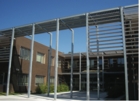Ground-source heat-pump system achieves high COPs

A 7-month trial of a Mitsubishi Electric ground-source heat-pump air-conditioning has shown a COP of 6.27, rising to 7.14 by recovering heat when there is a simultaneous demand for heating and cooling. The installation provides heating and cooling for the headquarters in Hoddesdon of civil-engineering and building contractor VolkerFitzpatrick and comprises seven City Multi WR2 condensing units and a close-loop ground array of 36 boreholes 100 m deep.
The system was installed by Cool Plant in conjunction with VolkerFitzpatrick.
VolkerFitzpatrick designed the new building to enhance its corporate identity and showcase its sustainable credentials. Its building division designed and built the new office space, with its in-house building-services department specifying a wide range of energy efficient solutions to suit the overall building design.
The ground-source heat-recovery system is teamed up with other technologies. They include PQFY heat-pump boilers, solar-thermal preheating for hot water, Ecodan hot-water generator, ground-to-air technology, low-energy light fittings, daylight-saving lighting controls and PV brise soleil.
Steve Gray of Cool Plant says, ‘When we compare the results with alternative technologies and contract expected efficiency, we estimate a 46% reduction in running costs compared to a chiller and gas-boiler system, as well as a 53% reduction in CO2 emissions. The cost of heating and cooling the building using the ground-source system over the seven months was £1.29/m2.’







